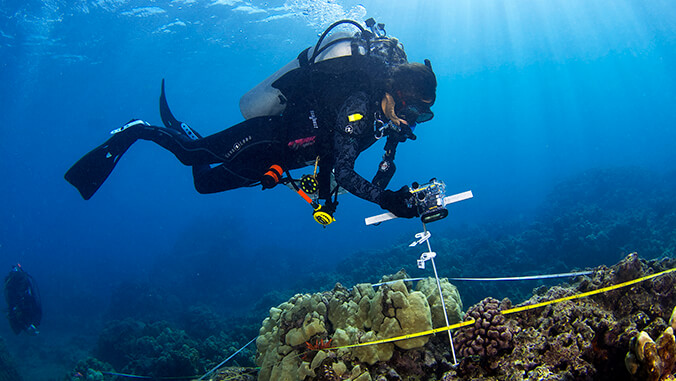
Since March, Hawaiʻi state orders have shut down Hanauma Bay to the public in response to the COVID-19 pandemic. University of Hawaiʻi at Mānoa researchers are using the closure to monitor the impacts on marine life and are starting to see signs that an absence in visitors could improve environmental conditions of the famous snorkeling beach.
Kuʻulei Rodgers is an associate researcher at the Hawaiʻi Institute of Marine Biology (HIMB) and principal investigator of the Coral Reef Assessment and Monitoring Program (CRAMP), a statewide long-term collaborative monitoring program.
“We are seeing the fish approach distance is reduced and the water visibility is clearer,” said Rodgers. “This may just be due to the weather conditions or other extraneous factors. As we survey more often, we will be able to quantitatively determine links to environmental conditions or lack of visitors.”
UH researchers are currently determining levels of suspended sediment in the water by comparing collected data prior to the closure with the data they will continue to collect following Hanauma Bay’s reopening. They are tracking fish movements and behavior of various species to see if any changes occur once Hanauma Bay reopens.
“We are also conducting fish surveys to determine any shifts in fish composition, abundance or biomass,” added Rodgers. “To examine coral recruitment and settlement, we are using fluorescent censusing techniques that can detect even the smallest recruits. We will also compare coral growth rates during the temporary closure and following the reopening to assess any differences.”
Hanauma Bay was one of the researchers’ first CRAMP sites initiated in 1999. HIMB’s coral reef ecology lab has continued to conduct research at Hanauma Bay throughout the years by monitoring the bleaching impacts, temperature and currents. In the past two years, researchers have been examining the carrying capacity of Hanauma Bay.
“Hanauma Bay Nature Preserve is very well managed considering the level of visitors,” said Rodgers. “The [City and County] management, the State Division of Aquatic Resources, lifeguards and Hawaiʻi Sea Grant education program work together to provide a safe and enjoyable experience for visitors. The research can drive adaptive management by providing sound scientific data for strategic planning and management decisions.”
—By Sarah Hendrix

